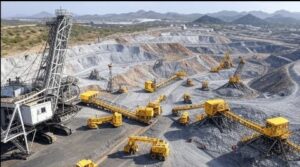TORONTO, ONTARIO–(Marketwired – Jan. 14, 2016) – Alamos Gold Inc. (TSX:AGI)(NYSE:AGI) ("Alamos" or the "Company") today reported fourth quarter and annual 2015 production. The Company also provided 2016 production and operating guidance.
"We closed 2015 on a strong note achieving full year guidance with record production of 104,700 ounces of gold in the fourth quarter. The strong fourth quarter performance was driven by improved production from the high grade mill at Mulatos and record production from Young-Davidson where we achieved our year-end underground mining rate target of 6,000 tonnes per day," said John A. McCluskey, President and Chief Executive Officer.
"Through merger and acquisition, capital investment, and cost reduction we have built a stronger company that is better positioned to navigate the challenges of the current gold price environment. As we execute on our core plan of completing the underground ramp up at Young-Davidson and developing the Cerro Pelon and La Yaqui deposits at Mulatos, we expect the benefits of these efforts will continue to unfold," Mr. McCluskey added.
Fourth Quarter and Full Year 2015 Operating Highlights
- Achieved guidance with production of 380,000 ounces of gold in 2015
- All-in sustaining costs have not been finalized but are expected to be consistent with guidance at the mine site level
- Reported record quarterly production of 104,734 ounces of gold in the fourth quarter of 2015, including 44,694 ounces from Young-Davidson, 41,830 ounces from Mulatos and 18,210 ounces from El Chanate
- Increased underground mining rates to average a new record of 5,900 tonnes per day ("tpd") in the fourth quarter at Young-Davidson, and over 6,000 tpd in December, consistent with the year-end target
- Achieved a new record low in terms of unit mining costs at Young-Davidson of $27 (CAD$35) per tonne benefiting from a nine month hydro rebate of $2 (CAD$3)per tonne recorded in the fourth quarter
- Sold 104,419 ounces of gold in the fourth quarter of 2015 at an average realized price of $1,109 per ounce, $3 per ounce above the London Fix, for revenues of$115.8 million
2016 Guidance Overview
- Production guidance of 370,000 to 400,000 ounces of gold, an increase over 2015 with production growth from both Young-Davidson and Mulatos
- Expect consolidated all-in sustaining costs to decrease by over $100 per ounce to $975 per ounce driven by an 18%, or $175 per ounce decrease in all-in sustaining costs at Young-Davidson to $825 per ounce
- Global capital budget of $138-158 million in 2016, representing a 20% decrease from the mid-point of 2015 guidance
- With a focus on margin expansion, the Company has accelerated the transition to owner development at Young-Davidson. This will have an immediate impact, reducing per metre development spending and resulting in substantial capital and operating savings over the next several years
- All mines are expected to self-finance exploration, sustaining and growth capital spending and be free-cash flow neutral in 2016 at a gold price of $1,100 per ounce
- Corporate and administrative expenses are expected to decrease to $16 million (excluding stock based compensation), a $9 million, or 36% reduction from the combined Alamos and AuRico 2015 budgets prior to the merger
Fourth Quarter and Full Year 2015 Operating Results
| Three months ended | Twelve months ended | ||||||||
| December 31, 2015 | December 31, 2014 | December 31, 2015 | December 31, 2014 | ||||||
| Gold production (ounces) | |||||||||
| Young-Davidson | 44,694 | 40,945 | 160,358 | 156,753 | |||||
| Mulatos (1) | 41,830 | 42,500 | 140,330 | 140,500 | |||||
| El Chanate | 18,210 | 15,638 | 79,312 | 67,279 | |||||
| Total gold production | 104,734 | 99,083 | 380,000 | 364,532 | |||||
| (1) | Operating results from Mulatos prior to July 2, 2015 have been added for comparative purposes only. |
Young-Davidson
Young-Davidson produced a record 44,694 ounces of gold in the fourth quarter, up from 38,201 ounces in the third quarter of 2015 and 40,945 ounces in the fourth quarter of 2014. The increase was driven by higher underground mining rates. Underground grades averaged 2.58 grams per tonne of gold ("g/t Au") in the fourth quarter and 2.67 g/t Au for the full year, consistent with the mineral reserve grade of 2.74 g/t Au. Underground mining rates averaged a new record of 5,900 tpd in the fourth quarter and over 6,000 tpd in December, consistent with guidance. The mill operated at an average of 7,630 tpd in the fourth quarter with lower grade open pit stockpiled ore supplementing the higher grade underground ore feed. The increase in underground mining rates drove the processed grade higher to average 2.17 g/t Au in the fourth quarter and 2.02 g/t Au for the full year. Recoveries averaged 91% in the fourth quarter and 89% for the full year.
For the full year, Young-Davidson produced 160,358 ounces of gold, consistent with guidance and up from 156,753 ounces in 2014. The increase reflected higher underground mining rates and recoveries.
Mulatos
Mulatos produced 41,830 ounces of gold in the fourth quarter of 2015, up 52% from 27,500 ounces in the third quarter, reflecting the recovery of deferred production from the seasonally weak third quarter and a strong improvement from the high grade mill. The open pit heap leach operation at Mulatos continued to perform well in the quarter with grades stacked on the leach pad of 0.94 g/t Au, well above the full year guidance of 0.80 g/t Au. For the full year, stacked grades averaged 0.87 g/t Au, again above the full year budget. Combined total throughput rates averaged 17,700 tpd in the quarter consistent with the budget and up sharply from the third quarter reflecting the end of the rainy season and higher mill throughput. The mill operated at improved throughput rates of 440 tpd in the quarter driving the strong increase in high grade production. For the full year, Mulatos produced 140,330 ounces of gold, below full year guidance reflecting the slower commissioning of the mill.
El Chanate
El Chanate produced 18,210 ounces of gold in the fourth quarter of 2015, down from 21,932 ounces in the third quarter, though up from 15,638 ounces in the fourth quarter of 2014. This closed off a record year at El Chanate with production of 79,312 ounces of gold exceeding guidance of 65,000 to 75,000 ounces. The operation generated positive free cash flow in 2015 in a challenging gold price environment, reflecting disciplined cost control.
2016 Guidance
Alamos' core focus in 2016 is on lowering costs and capital spending while continuing the ramp up at Young-Davidson and expansion at Mulatos. The Company expects to produce between 370,000 and 400,000 ounces of gold in 2016 at substantially lower costs and capital spending levels. All-in sustaining costs are expected to decrease to $975 per ounce of gold sold, driven by an 18%, or $175 per ounce decrease at Young-Davidson (based on the mid-point of 2015 guidance). Total capital spending for the Company's operating assets is also expected to decrease to between $111 and $131 million, down 19% from the mid-point of 2015 guidance. Given the decrease in costs and capital spending, the Company expects each operation to self-finance its sustaining and growth capital and exploration spending at a gold price of $1,100 per ounce.
| 2016 Guidance | |||||||||||||
| Young-Davidson | Mulatos | El Chanate | Total | ||||||||||
| Gold production (000's ounces) | 170-180 | 140-150 | 60-70 | 370-400 | |||||||||
| Total cash costs ($ per ounce) (1) | $ | 600 | $ | 850 | $ | 1,100 | $ | 800 | |||||
| All-in sustaining costs ($ per ounce) (1),(3) | $ | 825 | $ | 925 | $ | 1,100 | $ | 975 | |||||
| Capital expenditures (in millions) | |||||||||||||
| Sustaining capital(1) | $ | 40-45 | $ | 10-15 | $ | 1 | $ | 51-61 | |||||
| Growth capital(1) | $ | 45-50 | $ | 15-20 (2) | – | $ | 60-70 | ||||||
| (1) | Refer to the "Cautionary non-GAAP Measures and Additional GAAP Measures" disclosure at the end of this press release for a description of these measures. | |
| (2) | Excludes capitalized exploration. | |
| (3) | Total consolidated all-in sustaining costs include corporate and administrative and share based compensation expenses. For the purposes of calculating all-in sustaining costs at individual mine sites, the Company does not include corporate and administrative and share based compensation expenses. |
The 2016 production forecast and operating cost estimates are based on the following assumptions:
| 2016 Operating Assumptions | |||
| Gold price | $ | 1,100 | |
| United States dollar:Canadian dollar foreign exchange rate | $ | 0.75:1 (1) | |
| Mexican peso:United States dollar foreign exchange rate | 16:1 (2) |
| (1) | The Company has entered into foreign exchange transactions representing approximately 66% of its operating and capital costs at Young-Davidson ensuring a maximum USD/CAD foreign exchange rate of $0.80:1 and allowing the Company to participate in weakness in the USD/CAD up to a rate of $0.71:1. | |
| (2) | The Company has entered into foreign exchange transactions representing approximately 30% of its Mexican operating costs (80% of its Mexican peso-denominated costs) ensuring a minimum MXN/USD foreign exchange rate of 15.8:1 and allowing the Company to participate in weakness in the MXN/USD up to a rate of 19.1:1. |
Corporate and Administrative
Corporate and administrative expenses are expected to decrease to $16 million (excluding stock based compensation) in 2016, down from the combined Alamos and AuRico 2015 budgets of $25 million prior to the merger. In addition, the Company expects to benefit from $11 million in operational and tax savings in 2016 and beyond. Annual synergies arising from the merger total approximately $20 million, double what was initially guided on announcement of the merger.
Young-Davidson
Gold production at Young-Davidson is expected to increase approximately 9% in 2016 to between 170,000 and 180,000 ounces driven primarily by the ongoing ramp up of underground mining rates. Underground mining rates are expected to increase from approximately 6,000 tpd early in 2016 to a rate of 7,000 tpd by the end of the year.
With a focus on margin expansion and given Alamos' strong cash position, the Company has accelerated the transition to 100% owner underground development. This will have an immediate impact, reducing per metre development costs as approximately 35% of the underground development at Young-Davidson was being completed by contractor in the fourth quarter of 2015. This will result in higher capital spending in the first half of 2016 as required equipment is purchased but will result in substantially lower capital spending over the next several years, positively impacting cash flow.
Underground mined grades are expected to average 2.7 g/t Au in 2016, consistent with 2015 and the mineral reserve grade. Lower underground grades are expected in the first half of 2016, though these will increase in the second half to average 2.7 g/t Au for the full year. Mill throughput is expected to average 7,800 tpd. Mill feed from the underground mine will continue to be supplemented by stockpiled open pit ore until underground mining rates ramp up to the mill capacity. Mill recoveries are expected to average approximately 90%, consistent with 2015.
Higher mining rates, ongoing productivity improvements, and a weaker Canadian dollar are expected to drive total cash costs lower to $600 per ounce of gold sold. All-in sustaining costs are expected to decrease to $825 per ounce, an 18% or $175 per ounce decline from the mid-point of 2015 guidance of $1,000 per ounce.
Capital spending at Young-Davidson is expected to total between $85 and $95 million, including $40 to $45 million of sustaining capital. This represents a substantial decrease from 2015 levels despite the fact the Company is spending additional capital to accelerate the transition to underground owner development. Capital spending will be focused on development of the upper and lower mine, completion and commissioning of the MCM shaft and raise boring of the lower leg of theNorthgate shaft. In 2016, the Company expects Young-Davidson to generate sufficient cash flow to fund all sustaining and growth capital expenditures at a gold price of $1,100 per ounce. With the above noted equipment purchases expected to occur in the first half of 2016, approximately 65% of the full year budget will be spent over the first six months.
The Company expects a similar rate of capital spending until the ramp up of the underground mining rates to 8,000 tpd has been achieved. This is expected by mid-2017 after which the combination of higher production, lower costs and lower capital spending is expected to drive significant free cash flow growth.
Mulatos
Mulatos is expected to produce 140,000 to 150,000 ounces of gold in 2016, an increase from 2015 production of 140,330 ounces. All-in sustaining costs are expected to decrease to $925 per ounce of gold sold reflecting higher open pit grades, increased high grade mill production and various cost synergies. Total cash costs are expected to average $850 per ounce of gold sold.
Open pit grades mined and stacked on the heap leach pad are expected to increase to an average of 0.89 g/t Au, up from the 0.87 g/t Au stacked in 2015. The waste to ore ratio is expected to decline to 1.10:1 from a budget of 1.27:1 in 2015.
Milled grades are expected to average approximately 7.9 g/t Au, above the current mineral reserve grade as the Company continues to encounter higher grades, but fewer tonnes at San Carlos.
Total crusher throughput is expected to average 18,600 tpd, including approximately 475 tpd from the mill. This represents a 6% increase over total crusher throughput of 17,500 tpd in 2015 reflecting both higher throughput rates from the mill and crushing circuit. The combined recovery ratio is expected to average 66% reflecting higher grades stacked late in 2016 and a higher proportion of mixed and sulphide ore stacked. Open pit, heap leach recoveries are expected to increase to approximately 70% in 2017 and beyond.
The open pit heap leach operation continues to be the driver and is expected to supply approximately 80% of production in 2016. The Company continues to exploit opportunities for further cost reductions, including shortening waste haul routes; however, the main focus is on expanding and developing the higher grade La Yaqui and Cerro Pelon satellite projects. Cerro Pelon and La Yaqui will be substantially lower cost operations and are expected to start contributing production and drive costs lower in 2017. Both projects continue to advance with the environmental impact assessment ("EIA") for La Yaqui expected to be submitted in the first quarter of 2016. The EIA submission for Cerro Pelon is expected to follow in the third quarter.
These deposits are also among the highest priority exploration targets for Alamos with results from the 2015 drill program indicating strong potential to expand their mineral reserve and resource base. Given their low cost profile, any expansion of these projects is expected to have a positive impact on profitability of Mulatos.
Capital spending at Mulatos is expected to total $25-35 million which includes $10-15 million of sustaining capital. This is down from 2015 reflecting cost control initiatives and lower spending on underground development at San Carlos.
As with Young-Davidson, the Company expects Mulatos to generate sufficient cash flow to fund all exploration, sustaining and growth capital spending for the full year. Following the development of Cerro Pelon and La Yaqui in 2017, the Company expects a further reduction in costs and a substantial increase in free cash flow from Mulatos.
El Chanate
El Chanate is expected to produce 60,000 to 70,000 ounces of gold in 2016, down from 79,312 ounces in 2015 primarily reflecting lower throughput rates. Total crushed and run of mine ore is expected to average 18,500 tpd, down from 20,400 tpd in 2015 as part of an optimized mine plan in 2016 that will lower stripping requirements. The processed grade (run of mine and crushed ore) is expected to average 0.64 g/t Au.
All-in sustaining costs are expected to average $1,100 per ounce of gold sold. Total cash costs are expected to be in a similar range and are not comparable to 2015 as the Company expects to expense all waste stripping costs in 2016.
El Chanate is a mature operation with a relatively short remaining mine life. The operation was successful in generating positive free cash flow in 2015 and the focus in 2016 and beyond will be on keeping the operation free cash flow positive. Given the long leach cycle at El Chanate, more than 100,000 recoverable ounces have built up in the leach pad. These ounces are expected to be recovered at low costs once mining ceases at the operation, providing significant free cash flow at the end of its mine life.
2016 Global Operating and Development Budget
| 2016 Guidance | 2015 Guidance | ||||||||||||
| Sustaining Capital | Growth Capital | Total | Total | ||||||||||
| Operating Mines (in millions) | |||||||||||||
| Young-Davidson | $ | 40-45 | $ | 45-50 | $ | 85-95 | $ | 85-95 | |||||
| Mulatos | $ | 10-15 | $ | 15-20 | $ | 25-35 | $ | 40.6 | |||||
| El Chanate | $ | 1 | – | $ | 1 | $ | 17.5-20.0 | ||||||
| Total – Operating Mines | $ | 51-61 | $ | 60-70 | $ | 111-131 | $ | 143.1-155.6 | |||||
| Development Projects (in millions) | |||||||||||||
| Turkey | – | $ | 8 | $ | 8 | $ | 3.9 | ||||||
| Lynn Lake | – | $ | 8 | $ | 8 | $ | 5-10 | ||||||
| Esperanza | – | $ | 3 | $ | 3 | $ | 9.8 | ||||||
| Quartz Mountain | – | – | – | – | |||||||||
| Capitalized Exploration | – | $ | 8 | $ | 8 | $ | 15.3 | ||||||
| Total – Development Projects | – | $ | 27 | $ | 27 | $ | 34-39 | ||||||
| Total Consolidated Budget | $ | 51-61 | $ | 87-97 | $ | 138-158 | $ | 177.1-194.6 | |||||
2016 Capital Budget for Development Projects
At current gold prices, the Company's core focus is on completing the ramp up at Young-Davidson and developing the Cerro Pelon and La Yaqui satellite deposits at Mulatos. Capital spending on the Company's development projects has been scaled back significantly and will be focused on the highest priority targets. This includes completing the permitting process at Kirazli and continuing to advance Lynn Lake towards a feasibility study. At current gold prices, the Company does not anticipate spending significant capital on these projects until the ramp up at Young-Davidson and development of the satellite deposits at Mulatos has been completed and both operations are generating substantial free cash flow. Additionally, development spending and activities at Esperanza and Quartz Mountain have been significantly reduced.
Agi Dagi, Kirazli and Camyurt (Turkey) Development Budget
The 2016 budget for Turkey is $8 million which includes spending associated with completing the permitting process at Kirazli in addition to community and government relations and general administration. The Company expects to capitalize costs associated with the development of its Turkish assets during 2016.
The Company is currently applying for the forestry and operating permits which are required prior to construction, and remains confident that these permits will be granted. An updated capital budget for the project will be presented once all required permits are received; however, the capital budget is not expected to differ materially from the June 2012 preliminary feasibility study. The Company is however in the process of evaluating the impact of updated capital costs, forestry fee changes, tax incentive availability changes and the devaluation of the Turkish Lira on the operating costs and overall economics of its projects.
In the current gold price environment, the Company expects to defer any major capital spending on Kirazli until the above noted ramp up at Young-Davidson and development of the Mulatos satellite deposits are complete and both operations are generating significant free cash flow to help fund further growth.
Lynn Lake Development Budget
The capital budget for Lynn Lake in 2016 is $8 million, largely comprised of baseline work required for permitting and completing a feasibility level study. With the completion of the acquisition of Carlisle Goldfields earlier this month, the Company has consolidated 100% interest in the project. The focus over the next 18 months will be on completing a project description and feasibility study in preparation for permitting. Costs associated with the Lynn Lake project are expected to be capitalized in 2016.
2016 Exploration Budget
The 2016 exploration budget is $14 million of which approximately 75% will be capitalized. The majority of the 2016 exploration budget will be focused on the Cerro Pelon and La Yaqui satellite deposits with details as follows:
Cerro Pelon
A total of 670 metres ("m") of drilling was completed at Cerro Pelon during the fourth quarter and 18,767 m for the full year. The aim of the 2015 program was to test continuation of mineralization to the north of the current pit. The program was successful in delineating a new zone of mineralization approximately 100 m to the north of the reserve mineralization and outside previously designed pit limits. Excellent drill results were obtained with several intercepts averaging well above the current mineral reserve grade. Previously released highlight intercepts include:
- 2.37 g/t Au over 45.70 m (15PEL007)
- 3.83 g/t Au over 13.10 m (15PEL008)
- 2.46 g/t Au over 94.20 m and 2.21 g/t Au over 22.60 m (15PEL010)
- 14.47 g/t Au over 50.30 m (15PEL012)
- 9.65 g/t Au over 34.60 m (15PEL020)
- 4.07 g/t Au over 15.20 m and 2.24 g/t Au over 18.30 m (15PEL031)
- 4.78 g/t Au over 41.10 m (15PEL049)
- 3.94 g/t Au over 35.10 m (15PEL050)
- 4.26 g/t Au over 18.30 m (15PEL058)
In addition to drilling, significant mapping and sampling has been conducted over a large area around the reserve mineralization. Combined results from all programs indicate that gold mineralization at Cerro Pelon is associated with quartz-alunite alteration, brecciation and structures. Recent mapping and drilling is helping to further refine the Company's understanding of the controls on mineralization at Cerro Pelon. Results to date have indicated that favorable geology for hosting mineralization exists to the north beneath a massive silica cap. Preliminary metallurgical test work indicates mineralization is amenable to heap leaching.
The focus of the 2016 exploration program is to drill test an additional 500-800 m to the north with an expected budget of $3 million.
La Yaqui
A total of 3,497 m was drilled at La Yaqui during the fourth quarter of 2015 bringing the full year total to 17,518 m. The 2015 exploration program yielded excellent results with step out drilling identifying a new zone of mineralization 500 m to the northeast of in-pit reserve mineralization and further mineralized intercepts encountered over an additional 750 m of strike length. Previously released highlight intercepts include:
- 1.36 g/t Au over 117.40 m (15YAQ058)
- 1.34 g/t Au over 64.00 m (15YAQ061)
- 5.68 g/t Au over 15.20 m (15YAQ064) (approximately 350 m along strike from 15YAQ058)
- 2.03 g/t Au over 32.00 m (15YAQ068) (approximately 750 m along strike from 15YAQ058)
Drilling throughout 2015 has indicated the existence of a large hydrothermal system in the Yaqui area with continuous alteration over a large area of approximately 1.5 kilometres ("km") by 1 km and ore-grade intercepts at distances of up to a 1.25 km from known in-pit mineralization. Preliminary metallurgical test work indicates mineralization is amenable to heap leaching. The results of the 2015 program at La Yaqui will not be incorporated into the 2015 year end mineral reserve and resource statement planned for the end of March 2016, but will be incorporated into subsequent updates.
A system of this size will require systematic testing and infill drilling. Therefore, the 2016 program will be conducted in two phases. The first will be focused on ongoing exploration along the northwest-trending massive silica ridge. This will be followed by systematic delineation and definition drilling over portions of this approximately 1,000 m strike length with the aim of increasing mineral resources and reserves at La Yaqui. Approximately $5 million has been budgeted at La Yaqui for the year.
Qualified Persons
Chris Bostwick, FAusIMM, Alamos Gold's Vice President, Technical Services, has reviewed and approved the scientific and technical information contained in this news release. Chris Bostwick is a Qualified Person within the meaning of Canadian Securities Administrator's National Instrument 43-101 ("NI 43-101"). Information pertaining to the Mulatos District exploration program has been reviewed and approved by Alamos' Vice President, Exploration, Aoife McGrath, M.Sc., M.AIG, a Qualified Persons within the meaning of NI 43-101. For additional detail about the drill results contained herein, see Alamos' press release dated September 21, 2015. Drilling, sampling, QA/QC protocols and analytical methods for work areas in Mexico are as outlined in the NI 43-101 report titled, "Mulatos Project Technical Report Update" dated December 21, 2012, which can be viewed on SEDAR (www.sedar.com).
About Alamos
Alamos is a Canadian-based intermediate gold producer with diversified production from three operating mines in North America. This includes the Young-Davidsonmine in northern Ontario, Canada and the Mulatos and El Chanate mines in Sonora State, Mexico. Additionally, the Company has a significant portfolio of development stage projects in Mexico, Turkey, Canada and the United States. Alamos employs more than 1,300 people and is committed to the highest standards of sustainable development. The Company's shares are traded on the TSX and NYSE under the symbol "AGI".
The TSX and NYSE have not reviewed and do not accept responsibility for the adequacy or accuracy of this release.
Cautionary Note
This News Release includes certain "forward-looking statements". All statements other than statements of historical fact included in this release, including without limitation statements regarding forecast gold production, gold grades, recoveries, waste-to-ore ratios, total cash costs, potential mineralization and reserves, exploration results, and future plans and objectives of Alamos, are forward-looking statements that involve various risks and uncertainties. These forward-looking statements include, but are not limited to, statements with respect to mining and processing of mined ore, achieving projected recovery rates, anticipated production rates and mine life, operating efficiencies, costs and expenditures, changes in mineral resources and conversion of mineral resources to proven and probable reserves, and other information that is based on forecasts of future operational or financial results, estimates of amounts not yet determinable and assumptions of management.
Exploration results that include geophysics, sampling, and drill results on wide spacings may not be indicative of the occurrence of a mineral deposit. Such results do not provide assurance that further work will establish sufficient grade, continuity, metallurgical characteristics and economic potential to be classed as a category of mineral resource. A mineral resource that is classified as "inferred" or "indicated" has a great amount of uncertainty as to its existence and economic and legal feasibility. It cannot be assumed that any or part of an "indicated mineral resource" or "inferred mineral resource" will ever be upgraded to a higher category of resource. Investors are cautioned not to assume that all or any part of mineral deposits in these categories will ever be converted into proven and probable reserves.
Any statements that express or involve discussions with respect to predictions, expectations, beliefs, plans, projections, objectives, assumptions or future events or performance (often, but not always, using words or phrases such as "expects" or "does not expect", "is expected", "anticipates" or "does not anticipate", "plans", "estimates" or "intends", or stating that certain actions, events or results "may", "could", "would", "might" or "will" be taken, occur or be achieved) are not statements of historical fact and may be "forward-looking statements." Forward-looking statements are subject to a variety of risks and uncertainties that could cause actual events or results to differ from those reflected in the forward-looking statements.
There can be no assurance that forward-looking statements will prove to be accurate and actual results and future events could differ materially from those anticipated in such statements. Important factors that could cause actual results to differ materially from Alamos' expectations include, among others, risks related to international operations, the actual results of current exploration activities, conclusions of economic evaluations and changes in project parameters as plans continue to be refined as well as future prices of gold and silver, as well as those factors discussed in the section entitled "Risk Factors" in Alamos' and AuRico Gold's Annual Information Forms and other disclosures of "Rick Factors" by Alamos and its predecessors, available on SEDAR and EDGAR. Although Alamos has attempted to identify important factors that could cause actual results to differ materially, there may be other factors that cause results not to be as anticipated, estimated or intended. There can be no assurance that such statements will prove to be accurate as actual results and future events could differ materially from those anticipated in such statements. Accordingly, readers should not place undue reliance on forward-looking statements.
Cautionary Note to U.S. Investors
Alamos prepares its disclosure in accordance with the requirements of securities laws in effect in Canada, which differ from the requirements of U.S. securities laws. Terms relating to mineral resources in this presentation are defined in accordance with National Instrument 43-101 – Standards of Disclosure for Mineral Projects under the guidelines set out in the Canadian Institute of Mining, Metallurgy, and Petroleum Standards on Mineral Resources and Mineral Reserves. The United States Securities and Exchange Commission (the "SEC") permits mining companies, in their filings with the SEC, to disclose only those mineral deposits that a company can economically and legally extract or produce. Alamos may use certain terms, such as "measured mineral resources", "indicated mineral resources", "inferred mineral resources" and "probable mineral reserves" that the SEC does not recognize (these terms may be used in this presentation and are included in the public filings of Alamos, which have been filed with the SEC and the securities commissions or similar authorities in Canada).
Cautionary non-GAAP Measures and Additional GAAP Measures
Note that for purposes of this section, GAAP refers to IFRS. The Company believes that investors use certain non-GAAP and additional GAAP measures as indicators to assess gold mining companies. They are intended to provide additional information and should not be considered in isolation or as a substitute for measures of performance prepared with GAAP. Non-GAAP and additional GAAP measures do not have a standardized meaning prescribed under IFRS and therefore may not be comparable to similar measures presented by other companies.
"Cash operating costs per ounce" and "total cash costs per ounce" as used in this analysis are non-GAAP terms typically used by gold mining companies to assess the level of gross margin available to the Company by subtracting these costs from the unit price realized during the period. These non-GAAP terms are also used to assess the ability of a mining company to generate cash flow from operations. There may be some variation in the method of computation of "cash operating costs per ounce" as determined by the Company compared with other mining companies. In this context, "cash operating costs per ounce" reflects the cash operating costs allocated from in-process and dore inventory associated with ounces of gold sold in the period. "Cash operating costs per ounce" may vary from one period to another due to operating efficiencies, waste-to-ore ratios, grade of ore processed and gold recovery rates in the period. "Total cash costs per ounce" includes "cash operating costs per ounce" plus applicable royalties. Cash operating costs per ounce and total cash costs per ounce are exclusive of exploration costs.
The Company has adopted an "all-in sustaining cost per ounce" non-GAAP performance measure. The Company believes the measure more fully defines the total costs associated with producing gold; however, this performance measure has no standardized meaning. Accordingly, there may be some variation in the method of computation of "all-in sustaining cost per ounce" as determined by the Company compared with other mining companies. In this context, "all-in sustaining cost per ounce" reflects total mining and processing costs, corporate and administrative costs, exploration costs, sustaining capital, and other operating costs. "Sustaining capital expenditures" are expenditures that do not increase annual gold ounce production at a mine site and excludes all expenditures at the Company's development projects as well as certain expenditures at the Company's operating sites that are deemed expansionary in nature. "Growth capital expenditures" represent the amount of expenditures at development projects and certain expenditures at operating sites with are deemed expansionary in nature.
Alamos Gold Inc.
Scott K. Parsons
Vice President, Investor Relations
(416) 368-9932 x 5439

















